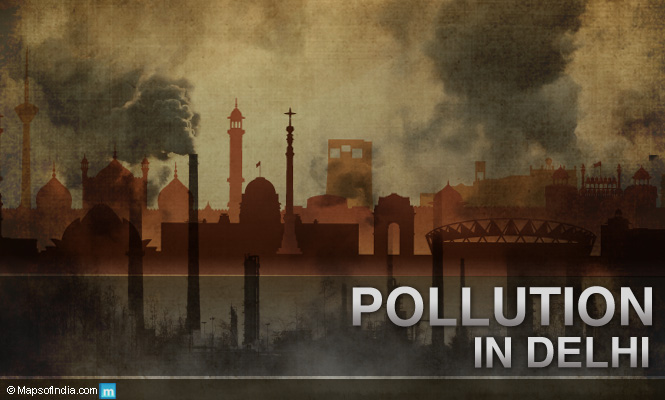Pollution is one of the major issues causing concern not only in India but across the world. The technological advancement and speedy development since India’s Independence has come at a great environmental cost. According to the global Environment Performance Index (EPI) 2018, India is ranked at 177 with an EPI of 30.57, and it is disheartening to hear that Delhi, the national capital of the country, is being tagged as one of the most heavily polluted capital cities in the world. It is the world’s worst city in terms of air pollution, with an unhealthy air quality index for the majority of the year. Thus, today, one of the biggest threats to the welfare of the people of Delhi and the city as a whole is pollution of various types
Classification of pollution in Delhi
- Air pollution
- Noise pollution
- Water pollution
- Domestic waste
- Industrial waste
- Vehicular pollution
- Hospital waste
- Solid waste etc.
Causes of pollution in Delhi
- Growing population of the city. The pressure and haphazard growth of the population is deteriorating the environment.
- There has been highly haphazard and unplanned development of industries and factories. Studies have revealed that only about 20% of the industrial units are set up in the approved industrial areas whereas the rest of them are in residential and commercial areas.
- There has been a huge rise in the vehicular population, in spite of the metro railways, aggravating traffic congestion and increasing air and noise pollution. It has also been reported that the number of vehicles plying on the roads of Delhi is more than that of the three metropolitan cities of Mumbai, Kolkata and Chennai taken together.
- There has also been an ever-increasing number of diesel vehicles plying on the roads, which are largely responsible for the air pollution.
- It has been reported by the National Environmental Engineering Research Institute (NEERI) that everyday almost 8,000 m tonnes of solid waste is being generated in Delhi. Plus we also have the industrial hazardous and non-hazardous waste. On an average, everyday, the MCDs and the NDMC manage to clear about 5,000-5,500 m tonnes of garbage. This results in the accumulation of more and more garbage in the city.
- There has been no proper technology or methods to treat solid, liquid, waste water, industrial and hospital wastes in the city.
- There has been too much dependence on fossil fuels like coal-fired power plants, improper use of energy in buildings and the excessive use of biomass for cooking and heating, etc
Particulate matter for measuring pollution
One way of measuring pollution is by the measure of particulate matter. Particulate matter is basically a mixture of extremely small particles and liquid droplets like acids, chemicals, gas, water, metals, soil dust particles, etc., the measurement of which gives an idea of the pollution of a city. It is also known as particle pollution or PM.
Pollution in Delhi: Facts and figures
- According to the Ambient Air Pollution (AAP) report for the year 2014, Delhi had PM 2.5 pollution levels, which is the highest in the world, followed by Beijing. This result was based on the monitoring of PM measurement of outdoor air pollution from almost 1,600 cities in 91 countries.
- The highest concentration of PM 2.5 form of air pollution is supposed to be a very serious matter and can lead to respiratory diseases and other health problems like lung cancer.
- According to the World Health Organization (WHO), air pollution is the fifth largest killer in India.
- Carbon monoxide (CO), a dangerous gas emission, is around 6,000 microgram per cubic metre in Delhi, which is much above the safe level of 2,000 microgram per cubic metre.
- The level of nitrogen dioxide (NO2) has also been increasing.
- According to the Ministry of Earth Sciences, Delhi’s air quality index (AQI) is 121, which is described as “poor.” The AQI is an index for reporting daily air quality, about how clean or polluted the air is.
Government’s steps to control pollution in Delhi
- There are mobile enforcement teams deployed at various locations for monitoring polluting vehicles and vehicles not having PUC certificates.
- A Mass Rapid Transport System (MRTS) is being constructed with the aim of providing a non-polluting, useful and affordable rail-based mass rapid transit system for Delhi, integrated with other modes of transport.
- With a view to reducing vehicular pollution, there has been a ban imposed on the plying of more than 15 years old commercial/transport vehicles, taxis and autos that run on conventional fuels, including diesel driven city buses.
- There has also been tightening of mass emission standards for new vehicles.
- The quality of the fuel being supplied in Delhi has been significantly improved over the years by the ban of selling leaded petrol, introduction of low sulphur diesel, reduction of sulphur and benzene content in petrol.
- There has been regular placement of dustbins, purchase of additional front-end loaders, mechanical sweepers, dumper placers, tipper trucks, to collect and dispose of garbage.
- Steps are taken to transform garbage into compost by developing new sanitary landfill sites.
- The Delhi Government has constituted a committee to implement the Bio-Medical Waste (management and handling) Rules, 1998.
- The Delhi Degradable Plastic Bag (Manufacture, Sale and Usage) and Garbage (Control) Act 2000 has been enacted for banning the manufacture and use of plastic bags, etc.
- Government has banned the manufacturing of BSLV III engines, and implemented policy to ensure that only eco-friendly BSLV IV engine is manufactured.
- Kejriwal government has also imposed odd-even scheme three times in order to deal with stubble-burning situation in Delhi.
It’s not that the Government is not taking steps to control pollution in Delhi. But we need proper and efficient implementation of plans and programmes and policies launched by the Government.
How can citizens of Delhi help in reducing pollution?
Pollution in Delhi is a perpetual problem which need to be looked upon as a serious issue not only by the Government but also by the citizens of the city.
- One of the easiest ways is that there should be an efficient involvement of Resident Welfare Associations in various localities in collection, segregation of garbage from houses and the societies.
- Citizens can take steps to convert the garbage into compost in their localities.
- More and more trees must be planted in every locality.
- Every individual should keep a proper check on the pollution level of their vehicles.
- Making more use of CNG.
- One of the best ways to control pollution is to manage wastes of all types in a proper manner.
- Each and every citizen should abide by the 3Rs: Recycle, Reuse, Reduce.
- More and more people should use bus and metro instead of cars and scooters, as they can carry a lot more people in one journey. Car pool is also a good option.
- Controlling the use of energy and making use of electricity in an efficient manner.
- One can also reduce water pollution by reducing the use of chemicals, cleaning agents, pesticides, herbicides, fertilizers etc.
It is the duty of every citizen to think in a broader perspective to control pollution. We really don’t want our future generations to live in an unhealthy environment in Delhi. We really don’t want our children or our elders to get into incessant coughing due to pollution. Like we say charity begins at home, I take a pledge to do what I can for my environment and protect it to the best I can. If each one of us takes a pledge to do our bit for our environment, I am sure Delhi will be a better place to live in. Even a small step counts…
Read More:
Most Polluted Cities in India
Pollution in Delhi after Diwali Celebration
Delhi’s Odd-Even Scheme Observations
Delhi’s odd-even car rule to reduce pollution
How can Delhi bring down its pollution levels?
Air Pollution in Delhi is Caused by Vehicles
Pollution in Delhi: Industrial Units Choking Residential Areas
Vehicular Pollution in Delhi and Its Impact on Lotus Temple
Plastic Pollution: A Threat to Ecosystem
Air pollution in India
River Pollution in India
Pollution Control in India






